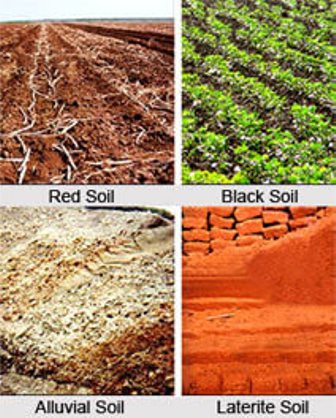Types of Soil

Types of Soil
Types of soil: The difference in particle size of the various soil constituents gives rise to a property called texture. The easiest way to identify the type of soil is to take some, wet it, and roll it between your fingers.
Based on the proportion of sand, silt, clay, and humus present, soil can be sandy, clayey.
| SandySoil | Clayey Soil | Loamy soil |
| More than two third of sandy soil is sand and about one third is clay. | More than two - third of clayey soil is clay. | Loamy soil has sand and silt in equal amounts, about two fifth each. One fifth of loamy soil is clay. |
| It is made up of large particles with large air spaces. | It is made up of fine particles with small air spaces. | It has high humus content. |
| Its porosity prevents retention of water. So it dries up early. | It retains moisture and becomes very sticky when wet. | It is porous and also holds moisture. |
| It is well suited for fruit and vegetable cultivation. | It is good for making pots. | It is god for cultivation of crops and gardening. |
Types of Soil: On the basis of proportion of particles of various sizes soil can be classified as.
(i) Sandy soil: If soil contains greater proportion of big particles it is called sandy soil.
(ii) Clayey soil: In such a soil the porportion of fine particles is relatively higher.
(iii) Loamy soil: In such a soil the amount of large and fine particles is about the same.
Geographically, Indian soil can be classified in to following type :
1. Red soil : This soil is red in colour due to the presence of large amounts of iron oxide.
2. Black soil : It is rich in the minerals, iron and magnesium. This soil is suitable for the growth of sugarcane and cotton.
3. Alluvial soil : This sandy, formed by the weathering of rocks is brought down by flowiing rivers fro the mountains. It is vary fertile and rich in humus. It is suitable for the cultivation of wheat, rice and sugarcane.
4. Desert soil : This sandy soil does not hold much water. Cacti, Date palm, Coconut palm, etc. which do not need much water grow in this type of soil.
5. Mountain soil : This is highly fertile soil contains the highest humus content.
6. Laterite soil : This soil is found in regions of heavy rainfall. It is good for the growth of plantation crops like coffee, tea, coconut anf banana.


Which of the following soils are good at retaining water ? | |||
| Right Option : C | |||
| View Explanation | |||
| |||
| Right Option : B | |||
| View Explanation | |||
___________________ are the types of soils. | |||
| Right Option : D | |||
| View Explanation | |||
Students / Parents Reviews [10]
About Abhyas metholodology the teachers are very nice and hardworking toward students.The Centre Head Mrs Anu Sethi is also a brilliant teacher.Abhyas has taught me how to overcome problems and has always taken my doubts and suppoeted me.

Shreya Shrivastava
8thIt was good as the experience because as we had come here we had been improved in a such envirnment created here.Extra is taught which is beneficial for future.

Eshan Arora
8thMy experience was very good with Abhyas academy. I am studying here from 6th class and I am satisfied by its results in my life. I improved a lot here ahead of school syllabus.

Ayan Ghosh
8thMy experience with Abhyas is very good. I have learnt many things here like vedic maths and reasoning also. Teachers here first take our doubts and then there are assignments to verify our weak points.

Shivam Rana
7thIt was a good experience with Abhyas Academy. I even faced problems in starting but slowly and steadily overcomed. Especially reasoning classes helped me a lot.

Cheshta
10thOne of the best institutes to develope a child interest in studies.Provides SST and English knowledge also unlike other institutes. Teachers are co operative and friendly online tests andPPT develope practical knowledge also.

Aman Kumar Shrivastava
10thI have spent a wonderful time in Abhyas academy. It has made my reasoning more apt, English more stronger and Maths an interesting subject for me. It has given me a habbit of self studying

Yatharthi Sharma
10thAbhyas is a complete education Institute. Here extreme care is taken by teacher with the help of regular exam. Extra classes also conducted by the institute, if the student is weak.

Om Umang
10thMy experience with Abhyas academy is very good. I did not think that my every subject coming here will be so strong. The main thing is that the online tests had made me learn here more things.

Hiya Gupta
8thA marvelous experience with Abhyas. I am glad to share that my ward has achieved more than enough at the Ambala ABHYAS centre. Years have passed on and more and more he has gained. May the centre flourish and develop day by day by the grace of God.






